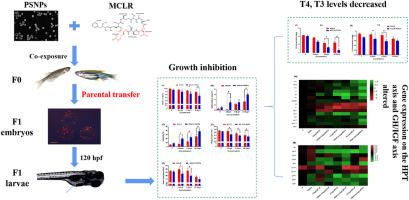Journal of Hazardous Materials ( IF 12.2 ) Pub Date : 2020-11-26 , DOI: 10.1016/j.jhazmat.2020.124677 Junli Zuo 1 , Tangbin Huo 2 , Xue Du 2 , Qing Yang 3 , Qin Wu 1 , Jianzhong Shen 1 , Chunsheng Liu 1 , Tien-Chieh Hung 4 , Wei Yan 5 , Guangyu Li 6

|
The coexistence of nanoplastics (NPs) and various pollutants in the environment has become a problem that cannot be ignored. In order to identify the microcystin-LR (MCLR) bioaccumulation and the potential impacts on the early growth of F1 zebrafish (Danio rerio) offspring in the presence of polystyrene nanoplastics (PSNPs), PSNPs and MCLR were used to expose adult zebrafish for 21 days. The exposure groups divided into MCLR (0, 0.9, 4.5 and 22.5 μgL-1) alone groups and PSNP (100 μgL-1) and MCLR co-exposure groups. F1 embryos were collected and developed to 120 hours post-fertilization (hpf) in clear water. Compared with the exposure to MCLR only, the combined exposure increased the parental transfer of MCLR to the offspring and subsequently exacerbated the growth inhibition of F1 larvae. Further research clarified that combined exposure of PSNPs and MCLR could reduce the levels of thyroxine (T4) and 3, 5, 3’-triiodothyronine (T3) by altering the expression of hypothalamus–pituitary–thyroid (HPT) axis-related genes, eventually leading to growth inhibition of F1 larvae. Our results also exhibited combined exposure of PSNPs and MCLR could change the transcription of key genes of the GH/IGF axis compared with MCLR single exposure, suggesting the GH/IGF axis was a potential target for the growth inhibition of F1 larvae in PSNPs and MCLR co-exposure groups. The present study highlights the potential risks of coexistence of MCLR and PSNPs on development of fish offspring, and the environmental risks to aquatic ecosystems.
中文翻译:

父母接触微囊藻毒素-LR和聚苯乙烯纳米塑料对斑马鱼后代生长的联合影响
纳米塑料(NPs)与环境中各种污染物的共存已成为一个不容忽视的问题。为了确定微囊藻毒素-LR (MCLR) 的生物累积以及在聚苯乙烯纳米塑料 (PSNPs) 存在下对 F1 斑马鱼 ( Danio rerio ) 后代早期生长的潜在影响,使用 PSNPs 和 MCLR 将成年斑马鱼暴露 21 天. 暴露组分为MCLR(0、0.9、4.5和22.5 μgL -1)单独组和PSNP(100 μgL -1) 和 MCLR 共同暴露组。收集 F1 胚胎并在清水中发育至受精后 (hpf) 120 小时。与仅暴露于 MCLR 相比,联合暴露增加了 MCLR 向后代的亲本转移,随后加剧了 F1 幼虫的生长抑制。进一步的研究表明,PSNPs 和 MCLR 的联合暴露可以通过改变下丘脑-垂体-甲状腺 (HPT) 轴相关基因的表达,最终降低甲状腺素 (T4) 和 3, 5, 3'-三碘甲状腺原氨酸 (T3) 的水平导致 F1 幼虫的生长抑制。我们的结果还表明,与 MCLR 单次暴露相比,PSNP 和 MCLR 的联合暴露可以改变 GH/IGF 轴关键基因的转录,表明 GH/IGF 轴是 PSNPs 和 MCLR 共同暴露组中 F1 幼虫生长抑制的潜在目标。本研究强调了 MCLR 和 PSNPs 共存对鱼类后代发育的潜在风险,以及对水生生态系统的环境风险。











































 京公网安备 11010802027423号
京公网安备 11010802027423号